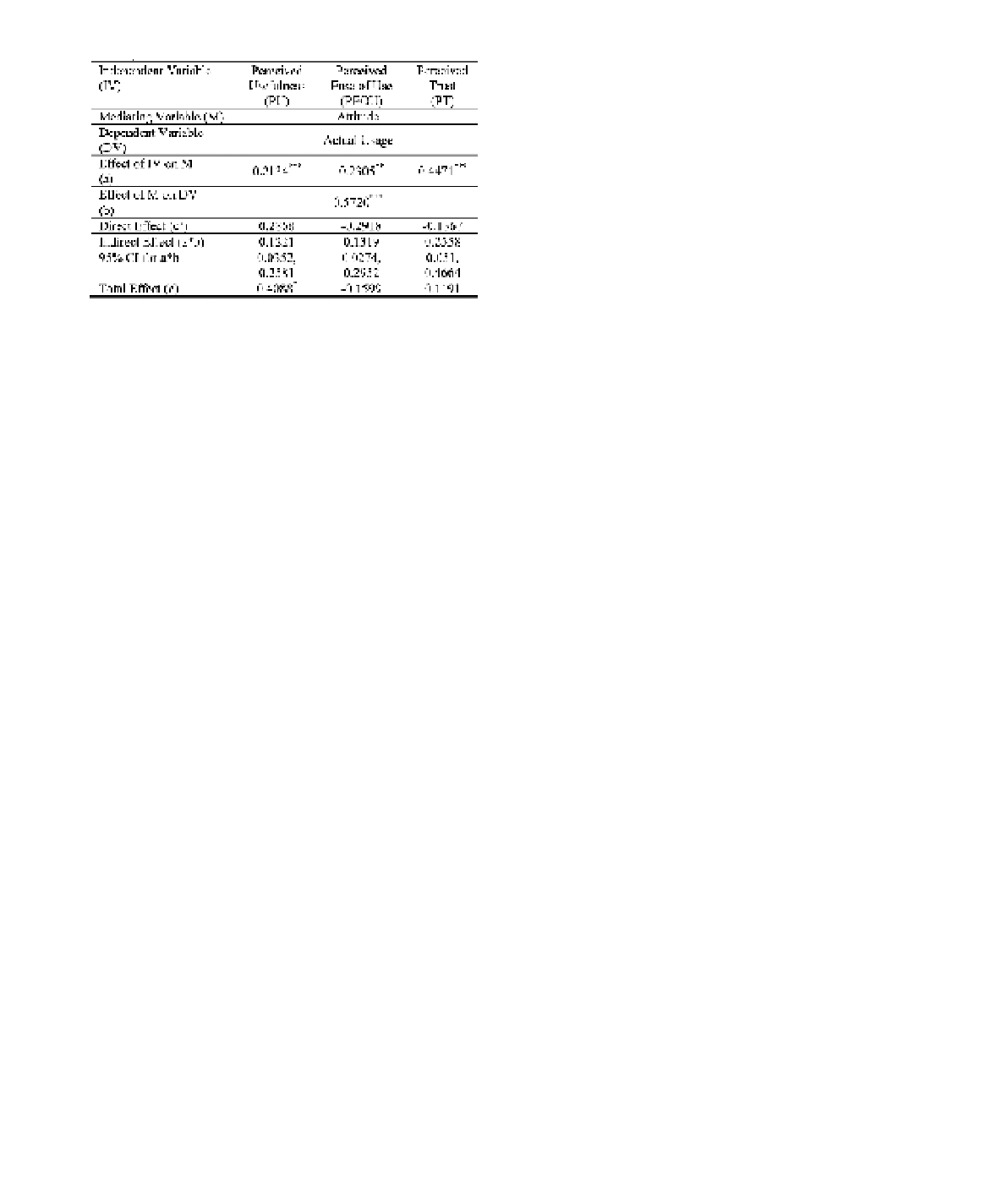Travel Reference
In-Depth Information
Table 3. Mediation on the effect of
Customer Respon-
siveness
on
Actual Usage
through
Attitude
(5,000 boot-
strap samples, N
Attoh-Okine, N. & Shen, L.D. (1995).
Security issues of
emerging smart cards fare collection application in mass
transit.
Paper presented at the Vehicle Navigation and
Information Systems Conference, 1995. Proceed-
ings. In conjunction with the Pacific Rim TransTech
Conference. 6th International VNIS.'A Ride into the
Future'.
Bank Negara Malaysia. (2011).
Central Bank of Malay-
sia Financial Sector Blueprint 2011-2020
. Retrieved
from www.bnm.gov.my.
Blythe, P.T. (2004). Improving public transport ticketing
through smart cards.
Proceedings of the ICE-Munici-
pal Engineer, 157
(1), 47-54.
Bruner II, G.C. & Kumar, A. (2005). Explaining con-
sumer acceptance of handheld Internet devices.
Jour-
nal of Business Research, 58
(5), 553-558.
Dabholkar, P.A. & Bagozzi, R.P. (2002). An attitudinal
model of technology-based self-service: moderat-
ing effects of consumer traits and situational factors.
Journal of the Academy of Marketing Science, 30
(3),
184-201.
Dani, A.R. & Krishna, P.R. (2001). An E-check frame-
work for electronic payment systems in the web based
environment
Electronic Commerce and Web Technolo-
gies
(pp. 91-100): Springer.
Davis, F.D., Bagozzi, R.P. & Warshaw, P.R. (1989). User
acceptance of computer technology: a comparison of
two theoretical models.
Management science, 35
(8),
982-1003.
Dempsey, P.S. (2008). Privacy issues with the use of smart
cards.
TCRP Legal Research Digest
(25).
Euromonitor International. (2011). Consumer
foodservice in Malaysia. Retrieved Decem-
ber 15, 2013 http://www.euromonitor.com/
Consumer_Foodservie_in_Malaysia
Fishbein, M. (1967).
Attitude, theory and measurement
.
New York, NY: John Wiley & Sons.
Fishbein, M. & Ajzen, I. (1975).
Belief, attitude, intention
and behavior: An introduction to theory and research
.
Addison-Wesley: Reading, MA.
Lu, H.K. (2007). Network smart card review and analy-
sis.
Computer Networks, 51
(9), 2234-2248.
Preacher, K.J. & Hayes, A.F. (2008). Asymptotic and
resampling strategies for assessing and comparing
indirect effects in multiple mediator models.
Behavior
research methods, 40
(3), 879-891.
Shelfer, K.M. & Procaccino, J.D. (2002). Smart card evo-
lution.
Communications of the ACM, 45
(7), 83-88.
Singh, S. (2009). Emergence of payment systems in the
age of electronic commerce: The state of art.
Global
Journal Business, 2
(2), 17-36.
Tabachnick, B.G. & Fidell, L.S. (2007).
Using multivariate
statistics
(5
th
ed.). Boston: Pearson/Allyn & Bacon.
Trépanier, M., Barj, S., Dufour, C. & Poilpré, R. (2004).
Examen des potentialités d'analyse des données d'un
système de paiement par carte à puce en transport
urbain (Examination of the Potential Use of Smart
Card Fare Collection System in Urban Transporta-
tion).
Paper presented at the Congrès annuel de 2004
de l'Association des transports du Canada, Québec.
United States Department of Transportation. (2010).
Obama administration proposes major public trans-
portation policy shift to highlight livability. In J.t.
Press Release FTA 01-10, 2010 (Ed.).
=
400).
*
p
< .05
,
**
p
< .01
,
***
p
< .001.
effects, it can be concluded Attitude mediates the
relationship between all Customer Responsiveness
dimensions and Actual Usage.
5 CONCLUSION
Smartcards have been implemented to facilitate res-
taurant services in light of different needs. The results
of the empirical findings contributed theoretically in
which generalizes the theory of reasoned action and
the technology acceptance model in undertaking
research on customer perceptions of emerging pay-
ment technologies in the restaurant. Equally impor-
tant, the findings have implications for management
to implement advanced payment technology to ease
restaurant services. Meanwhile, it is undoubtedly
may also shed light on the importance of attitude
in determining the customer's actual usage behav-
ioral to use the payment technology and adjacent
to that it promises substantial improvement to the
restaurant industry as a whole. Hence, understand-
ing customer attitudes towards the use of Touch 'n
Go card, had better outcome in enhanced model
of behavior, which is gradually more significant to
researchers concentrated on the acceptance of indi-
vidual behavior. Customers need to be continuously
educated and motivated to change their payment
habits by promoting the benefits of e-payments.
This will eventually pave the way for the acceptance
of e-payments on a national scale.
REFERENCES
Ajzen, I. & Fishbein, M. (1980).
Understanding attitudes
and predicting social behaviour
. Englewood Cliffs, NJ:
Prentice Hall.
Anand, R.S. & Madhavan, C.V. (2000). An online, trans-
ferable e-cash payment system
Progress in Cryptolo-
gy—INDOCRYPT 2000
(pp. 93-103): Springer.




Search WWH ::

Custom Search